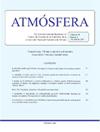阿根廷圣克鲁斯省的气候区划
IF 1
4区 地球科学
Q4 METEOROLOGY & ATMOSPHERIC SCIENCES
引用次数: 0
摘要
气候区划对于表征时空气候变率、编制气象预报、分析不同尺度的趋势以及确定气候对人类活动的影响至关重要。目的是根据1995年至2014年期间的降雨和温度网格数据以及随后的特征,提出圣克鲁斯省的气候区划。为了实现这一目标,我们将非分层k-means聚类方法应用于月累积降雨量和月平均温度数据库。采用Feddema修正的Thornthwaite分类法对每个聚类进行分类。研究结果表明,圣克鲁斯省根据降雨量和温度分为11个气候区。最干燥和最温暖的地区位于该省的中部和东北部,最潮湿和最寒冷的地区位于南部和西南部。区划是许多应用气候研究的一个重要组成部分,它可以用于与农业、能源生产、水资源管理、极端天气事件和气候变化等有关的其他研究。在圣克鲁斯省气候尺度缩小的区域研究中,这种区划特别可用于检查气候变化的影响。此外,这一工具在研究干旱及其影响方面是必不可少的,有助于更好地了解造成干旱的气候现象。本文章由计算机程序翻译,如有差异,请以英文原文为准。
Climate regionalization of Santa Cruz province, Argentina
Climate regionalization is essential for characterizing spatial and temporal
climatic variability, producing meteorological forecasts, analyzing trends at different
scales and, determining the climatic impact on human activities. The aim was to propose
a climatic regionalization for Santa Cruz province, based on gridded data of rainfall
and temperature (period 1995 to 2014), and subsequent characterization. To achieve this
goal, we applied the non-hierarchical k-means clustering method to monthly accumulated
rainfall and monthly average temperature databases. The Thornthwaite classification
modified by Feddema was used to classify each cluster. Results from this study showed
that Santa Cruz province is divided into 11 climatic regions based on rainfall and
temperature. The driest and warmest regions are located in the center and northeast of
the province and the most humid and coldest ones in the south and southwest.
Regionalization is an important component of many applied climate studies and it can be
used in other studies related to agriculture, energy production, water resource
management, extreme weather events, and climate change, among others. This
regionalization in particular can be used to examine the impacts of climate change in
regional studies of climatic scale reduction in Santa Cruz province. As well as this
tool can be essential in the study of drought and its impacts and contributes to a
better understanding of the climatic phenomena that condition drought.
求助全文
通过发布文献求助,成功后即可免费获取论文全文。
去求助
来源期刊

Atmosfera
地学-气象与大气科学
CiteScore
2.20
自引率
0.00%
发文量
46
审稿时长
6 months
期刊介绍:
ATMÓSFERA seeks contributions on theoretical, basic, empirical and applied research in all the areas of atmospheric sciences, with emphasis on meteorology, climatology, aeronomy, physics, chemistry, and aerobiology. Interdisciplinary contributions are also accepted; especially those related with oceanography, hydrology, climate variability and change, ecology, forestry, glaciology, agriculture, environmental pollution, and other topics related to economy and society as they are affected by atmospheric hazards.
 求助内容:
求助内容: 应助结果提醒方式:
应助结果提醒方式:


